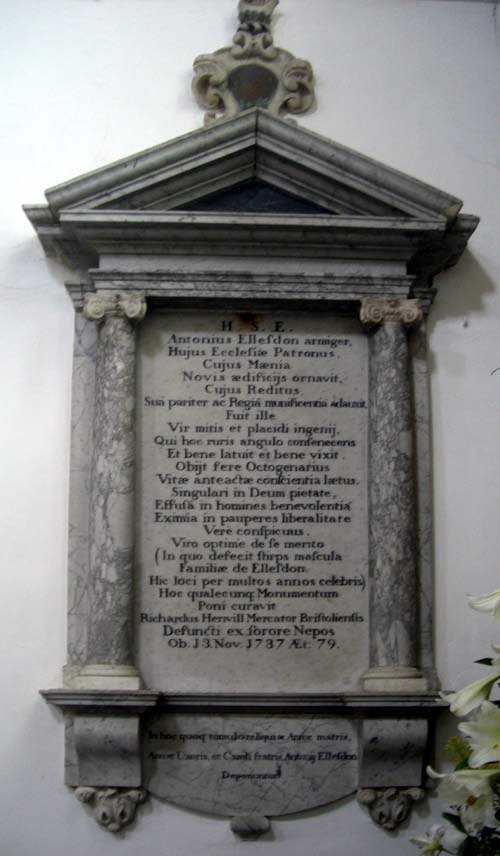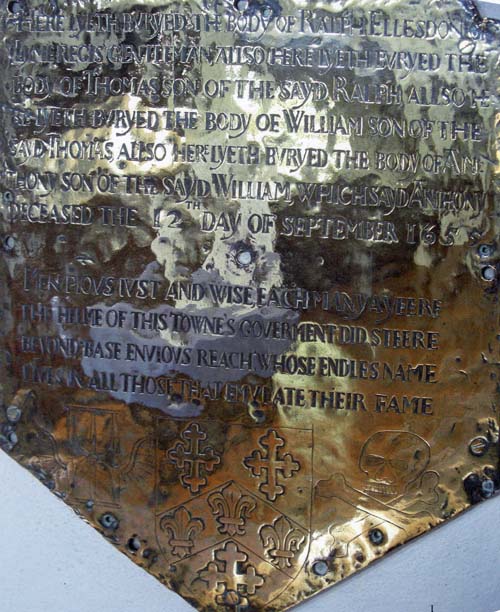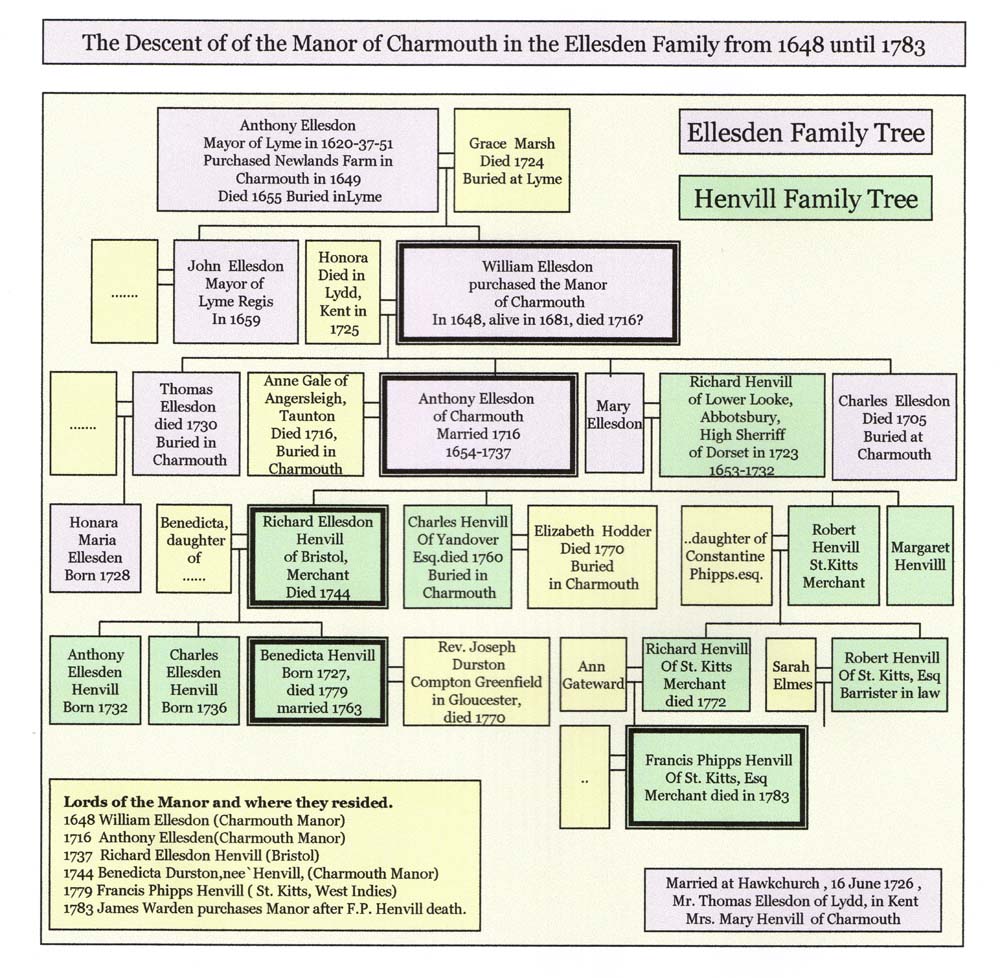Click on images or Charmouth Home to return back.




The Ellesdens (1648-1737)
At last Charmouth had as Lords of the Manor a family who were to reside in the Village. There are many references in the parish records to them and more significant is the beautiful Marble Memorial in the Church to Anthony Ellesdon. They would have lived in the Manor House in the Street, opposite the Church. The Ellesdons had been successful merchants in Lyme since the 15th century and had been Mayors of the town on frequent occasions. They lived in a mansion near the Church and there are records of “Ellesdons Lands” in the Manor rentals. Hutchins in his History of Dorset provides a family tree from Ralph, who was Mayor of the borough in 1521
(i) Anthony Ellesdon (died 1655)
In 1649 Anthony was to purchase Newlands Farm, which had formerly been part of Charmouth Manor from descendants of the Wadhams. Stonebarrow Manor may well have been a home to the Ellesdens in due course.
(ii) William Ellesdon
Perhaps Charmouth`s most famous son thanks to his role in one of the most exiting episodes in British History. For on 22nd September 1651 Charles II was to spend just one night in Charmouth, but its repercussions were to be momentous. If all had gone to plan he would have escaped with his life to St. Malo in France and Exile. Instead it was to be from Brighton twenty-four days later that he finally escaped. William Ellesdon was chosen by Colonel Wyndham to assist, but unfortunately the wife of Stephen Limbry, who was to ferry the King across to the boat found out and it had to be abandoned. Charles thought highly of Captain Ellesdon and later presented him with gold chain and medal bearing the inscription “Faithful to the horns of Altar” and a pension of £300 per annum. We are fortunate that William gave a very descriptive account of his involvement with the Kings escape which was later published in Clarendons “History of the Rebellion and Civil Wars in England”.
It was William Ellesdon who in 1648 was to buy the Manor of Charmouth from Sir John Pole. He was both a barrister at law, and a captain in the King's forces. The Hearth Tax shows him living at the Manor, with 6 hearths, by far the biggest house in the village.
The will of Honora, the wife of William is full of information about the family who seem to have property both in Dorset and around Lydd in Kent. She leaves her wealth to her eldest son Thomas and his brother Anthony in 1725. Again the Will of Thomas Ellesdon has survived with a detailed Inventory of his possessions and properties. He spends his last days at his brother Anthony's Manor House in the year 1730. He has considerable wealth, which includes gold and silver jewellery that is shown by its weight. This and his mother's inheritance were to all go Anthony.
(iii) Anthony Ellesdon (1654-1737)
Most of Anthony's life was to be spent in Charmouth and he is often referred to in Deeds and documents of the time. He would have no doubt lived in the Manor House, which would have been more imposing than what we see today after being subdivided and altered in the 19th century. In 1716 he married Anne Gale from Angersleigh, near Taunton in Somerset. Sadly he outlived all his family and his fortune and Estates were to be left to his sister's sons Richard and Charles. The Church in Charmouth has a painted board with the coat of arms of the family dated 1732 and a Silver Plate presented by Anthony in 1716. A document in the vestry dated 9th April 1714 is an Indenture between Anthony Ellesdon and Thomas Thorne of Hawkchurch, yeoman. "For the sum of £90 pd by Thorne hath demised all that tenement called Wade's Tenement in Mill Lane (Lower Sea Lane) and one piece of ground called Woollmington`s Close, lying in Lyme Lane, one orchard belonging and Davy` s Tenement, on a lease of 99 years, if Joane Thorne his wife and Joane and Mary his two daughters so long happen to live, paying rent yearly of six shillings, two fatt pulletts or eighteen pence of lawful money on 25th Pec each year Thomas Thome during the 99 years lease shall not fell any oak y ash or elm tree now growing or hereafter growing" signed by Anthony Ellesdon.
His nephew was to commission an elaborate marble monument to his uncle, which was transferred when the present church was built in 1836. He was patron of the church and paid for extensive improvements to it in 1732. From the long description of his acts of charity he would seemed to have been well liked. His Will shows him owning property in the parishes of Symondsbury, Lytton Cheney, Winterbourne Stapleton and Winterbourne Abbis in Dorset. It also refers to his father in that “I give to Richard Henvill the use of my medal set round with diamonds which was given by his late royal majesty King Charles II to my honoured father for his loyalty to the said king.”
(iv) Richard Ellesdon Henvill (died 1744)
It is interesting to speculate why the Henvill family were to become “Lords of the Manor of Charmouth”. Again Hutchins in his History of Dorset” reveals them to be already very wealthy and provides a family tree. It shows them originating in the early 17th century in Looke, near Abbotsbury. William Ellesdon`s daughter Mary, was to marry Richard Henvill of Lower Looke and have four children. Her husband was to become High Sherriff of Dorset in 1723. In 1669 his father Richard, had purchased the Manor of Catherston from Walter Yonge, bart, for £2,600 and no doubt the couple were to live in the imposing Manor House which sits high above Charmouth.
Anthony Ellesden in his will gives a substantial proportion of his wealth to his two nephews, Richard Ellesdon Henvill and Charles Henvill. It seems Charles is to stay in Charmouth and is married to Elizabeth Hodder and both are later buried here. His brother becomes Lord of the Manor, but it is probably Charles who lives in the Manor House. For Richard is often described as a Bristol Merchant and is very active in the Tobacco and Slave Trade. His brother Robert lives in St. Kitts in the West Indies and there a number of references to the family in records of the time. Richard Henill was one of the agents who were responsible for outfitting the ships, making the arrangements for the supply and selling of slaves. He was a leading agent directing many slaving voyages. In 1744 he gives evidence to the Lords Commissioners for Trade and plantations that Bristol sent out 40 slave ships per year each with goods on board worth £4000.
There are no references to him living in Charmouth despite being the Lord of the Manor. He and his wife have three children, but only their daughter, Benedicta survives. In matching up the various members of the families with the dates, the one I am totally confused about is a stray reference to a marriage between Mrs Mary Henvill of Charmouth and Thomas Ellesden of Lydd in 1726. Perhaps as more information comes to light the additional union between the two families will make sense.
(v) Benedicta Durston (1727-1779)
In 1744 at the age of just seventeen Benedicta Henvill inherits her fathers Estate which includes the manor of Charmouth and also the adjoining Manor of Catherstone. She is to later marry the Rev. Joseph Durston,Vicar of Compton Greenfield in Gloucester. But their marriage is short, for just seven years later in 1770 he passes away and she passes away a few years later. The couple are childless and the Estates pass to another branch of the Henvill family living in St. Kitts. Benedicta Durston is shown as living in the village after the death of her husband, probably at the Manor House as her name appears on a lease. It reveals that in 1771, Thomas Rickard, her Steward was leasing the property on the corner of the Street and Lower Sea Lane, currently known as Ida`s Village Stores from her for 6d per annum. Another lease for the same year shows her owning the building that was known as the “Wander Inn” on the Street in Charmouth.
At a Court Leet held on 5th Oct. 1770 it was stated that there ought to be a pair of Stocks erected. Later in 1778 there is an agreement made by her to construct a road to the sea ( now Lower Sea Lane). Her Will shows her leaving her Manor of Charmouth to her distant cousin Richard Henvill. The Manor of Catherston was left to his brother, Robert who was a Barrister on the Island of St. Vincent.
(vi) Francis Phipps Henvill (died 1783)
The Manor of Charmouth finally ends up being owned by a Merchant living with his family on the Island of St. Kitts in the West Indies. But it is only for four years as he is to die in 1783 and the Manor is put up for sale. The Sales particulars are very detailed with an Index to the Map of Charmouth Manor and Newlands Farm. Unfortunately the map has been lost, but the record is an indication of what property was still owned by the Lord of the Manor. It shows about 100 acres in Charmouth and 26 acres at Newlands Farm.
It would seem that unknown to most residents in Charmouth that their Village was owned by the Ellesdons and their descendants for over 130 years. Fortunately the Ellesdon Road is a reminder today of this important family.
Members of the Ellesdon family were Mayors of Lyme Regis seven times between 1521 and 1651, in which year Anthony Ellesdon held the office. In the ancient and interesting church of Lyme Regis is a brass in memory of four of them with the family arms and the lines : — " Men pious just & wise, each many a yeere The helme of this towne's government did steere Beyond base envious reach, whose endless name Lives in all those that emulate theire fame."
William Ellesdon, who subsequently furnished Lord Clarendon with the detailed account of his share in the events of September 22-3, 1651, had two sons, Anthony and Charles (the latter, born on June, 1661, named after the King). Anthony Ellesdon lived till 13 November, 1737, having survived his brother Charles thirty-two years. There is a monument to him in the new church at Charmouth, removed thither from the older building. His mother and wife as well as his brother Charles were buried in the same vault with Anthony. Richard Alford was on five occasions elected Mayor of Lyme before 1632, when he held the office for the last time. The " Captain" Alford, whose curious letter, bitterly attacking the good faith of his * See Vols. V (1906), pp. 20-23, ^^^ ^^ (1908), pp. 1-4. t The Rev. Joseph Ogle, who now lives at the " Manse " (formerly the " Queen's Head "),where Charles II and his friends passed the night of September 2 2-2 3,1651, contributed a very interesting article on the subject of Benjamin Wesley and the landlady of the " Queen's Head" entided "The Story of a King's Kiss " to the CMstian World of June 16, 1910.
Whilst it was long and often consulted concerning his Majesties transportation, a certain Merchant (whose name was Elsden) came into the mind of Mr. Windham, formerly a Captain under his Royal Father, who since that time had used the gainful Trade of a Merchant, in the Town of Lime, in whose power it was peradventure to provide a Ship, because he remembred that this Merchant procured a Transportation for the Lord Barkley, when he was in great distress. Therefore Mr. Windham is sent unto him, to enquire, whether he was able safely to transport the Lord Wilmot, and another Nohle-man, who had lately escap'd at Wor- cester Fight. He willingly consents unto it, and goes presently to Charmouth, a place bordering nigh Lime ; where applying himself to a
But afterwards it appears, that the Ship-Master returning home to his House, that so he might furnish himself with Linneni and other Necessaries, for the Voyage^ his Wife keeps him, by locking the Doors upon him. For upon the Fair day, there was Proclamation made in the Town, by which it was declared, 'That no man living, on fain of death, was to assist the King, or to conceal him ; and a thousaiid founds is to be given to a7iy man that shall discover him. By reason of which, this poor Woman is so affrighted, that she fears her Husband,
he young King, who had attained his twenty-first year in the preceding May, was disguised as a serving-man, and called, first. Will Jones, and then Will Jackson. After his arrival at Trent, Colonel Wyndham arranged with one Stephen Limbry, a Lyme skipper, that his vessel should take the fugitives on board at Charmouth, and convey them across the Channel. Early in the morning of Monday, September 2 2, Charles II, accompanied by Lord Wilmot, Colonel Wyndham, Miss Juliana Coningsby, and a serving-man, Henry Peters by name, made their way to Ellesdon Farm, a lonely house surrounded by woods, about two miles from Charmouth. Here they were met by Mr. William Ellesdon, whose account of the proceedings, in the shape of a letter addressed to Lord Clarendon, is preserved in the Bodleian Library at Oxford. Charles spent the afternoon at the farm, relieving the tedium of waiting by drilling a hole through a gold coin, which he subsequently presented to Ellesdon. In the evening the party moved to the " Blind " Inn at Charmouth, which for long years after was known as the Queen's Head. Here he passed the night, but in the early morning it became evident that some hitch had occurred. As a matter of fact, the handbills offering ;^I,ooo reward for the King's apprehension and threatening those who might harbour him with dire penalties, had so frightened Limbry's wife that she turned the key on her husband in order to prevent his carrying out the project he had agreed to. I will not here dwell on the incidents of his stay at Charmouth, which properly belong to the history of that picturesque village, and not to that of Bradpole. About noon on the following day the King and his companions reached the
